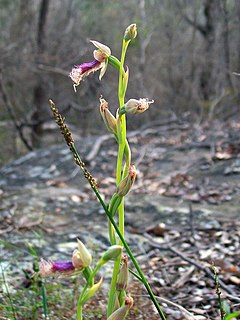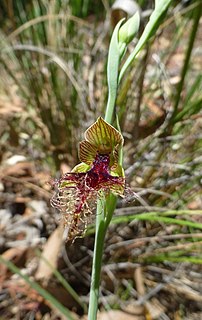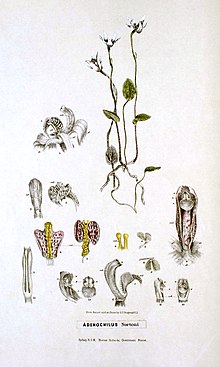
Adenochilus, commonly known as gnome orchids is a genus of two species of flowering plants in the orchid family Orchidaceae, one endemic to New Zealand and the other to Australia. Both species have a long, horizontal, underground rhizome with a single leaf on the flowering stem and a single resupinate flower with its dorsal sepal forming a hood over the labellum and column.

Calochilus robertsonii, commonly known as the purple beard orchid or purplish beard orchid, is a species of orchid native to Australia and New Zealand. It has a single dark green leaf and up to nine green to brown flowers with reddish or purplish stripes. The labellum has a glossy purple, mauve, or bronze-coloured beard with a ridge between the "eye" spots.
Caladenia ambusta, commonly known as the Boranup spider orchid, is a plant in the orchid family Orchidaceae and is endemic to the south-west of Western Australia. It has a single erect, linear leaf and a single creamy-coloured flower on a stem 27–35 cm (11–14 in) high. It is only known from a relatively small area south-west of Margaret River growing in deep sand in shrubland and woodland and only flowering profusely after fire.
Caladenia amoena, commonly known as the charming spider orchid, is a plant in the orchid family, Orchidaceae, and is endemic to Victoria. It is a ground orchid which grows singly or in small groups, has a single dark green, hairy leaf and a single yellowish-green flower with red stripes. It is only known from a few sites and has been classified as Endangered.

Caladenia attingens, commonly known as mantis orchids, are plants in the orchid family Orchidaceae and are endemic to the south-west of Western Australia. There are three subspecies, each of which has a single hairy leaf and one or two brightly coloured flowers with upswept sepals and a labellum with long, comb-like fringes. The subspecies differ in size, distribution and habitat.
Caladenia audasii is a plant in the orchid family Orchidaceae and is endemic to Victoria. It is a rare ground orchid with a single hairy leaf and a single yellow flower.
Caladenia cleistantha is a plant in the orchid family Orchidaceae and is endemic to the south-east of Australia. It is a ground orchid which occurs as solitary plants and has a singly hairy leaf and one or two cleistogamous flowers..
Caladenia conferta, commonly known as the crowded spider orchid or coast spider-orchid, is a plant in the orchid family Orchidaceae and is endemic to a restricted area in South Australia. It is a ground orchid with a single hairy leaf, and usually a single yellowish-green flower with red markings on a wiry, hairy stalk.

Caladenia congesta, commonly known as black-tongue caladenia, is a plant in the orchid family Orchidaceae and is endemic to Australia. It is a ground orchid with a single, sparsely hairy leaf, and up to three bright pink flowers with the central part of the labellum completely covered with black calli. It is a widespread species but not common in any part of its range.
Caladenia helvina, commonly known as the summer spider orchid, is a plant in the orchid family Orchidaceae and is endemic to Tasmania. It is a ground orchid with a single hairy leaf and usually a single greenish-yellow to pale yellow flower with reddish teeth on the sides of the labellum and reddish calli along its mid-line.

Caladenia moschata, commonly known as musky caps or musky caladenia, is a plant in the orchid family Orchidaceae and is endemic to eastern and south-eastern Australia, including Tasmania. It is a ground orchid with a single leaf and up to five flowers which are dark-coloured on the back and white on the front, sometimes tinged with pink and with a strong musky or soapy odour. The species was previously known as Caladenia gracilis.
Caladenia peisleyi is a plant in the orchid family Orchidaceae and is endemic to south-eastern Australia. It is a ground orchid with a single leaf and a single greenish-yellow flower with pale red stripes. It is difficult to distinguish from several other Caladenia species.
Caladenia pilotensis is a plant in the orchid family Orchidaceae and is endemic to Victoria. It is a ground orchid with a single leaf and one or two white or creamy-white flowers which sometimes have red lines. It is only known to occur on a single mountain.
Caladenia rigida, commonly known as the stiff spider orchid, or white spider-orchid is a plant in the orchid family Orchidaceae and is endemic to South Australia. It is a ground orchid with a single hairy leaf and one or two white flowers with dark glandular tips on the sepals and fine reddish-brown lines along the sepals and petals.
Caladenia ensigera is a plant in the orchid family Orchidaceae and is endemic to South Australia. It is a ground orchid with a single leaf and one or two greenish cream to whitish green flowers and is only known from Alligator Gorge in the Mount Remarkable National Park.
Caladenia flindersica is a plant in the orchid family Orchidaceae and is endemic to South Australia. It is a ground orchid with a single leaf and one or two cream-coloured flowers with thin dark red to blackish tips on the petals and sepals. It is only known from Alligator Gorge in the Mount Remarkable National Park.
Caladenia strigosa is a plant in the orchid family Orchidaceae and is endemic to South Australia. It is a ground orchid with a single leaf and a single greenish-cream flower with fine reddish streaks. It grows in sandy soil in shrubland.
Caladenia zephyra is a plant in the orchid family Orchidaceae and is endemic to South Australia. It is a ground orchid with a single, densely hairy leaf and a single cream-coloured to very pale yellow flower with blackish glandular hairs on the sepals and petals. It occurs on the Eyre Peninsula but may have a wider distribution.

Calochilus therophilus, commonly known as the late beard orchid, is a species of orchid endemic to eastern Australia. It has a single channelled, dark green leaf with a reddish base and up to fifteen dull greenish flowers with bold red stripes. The labellum has a dark purplish beard with two "eye" spots. Unlike that of other beard orchids, there is no prominent ridge between the eye spots.

Adenochilus gracilis is a plant in the orchid family Orchidaceae and is endemic to New Zealand. It has a long, thin underground rhizome, a single leaf on the flowering stem and a single white flower with glandular hairs on the outside. Its labellum has red to maroon bars and a central band of yellow calli but is almost obscured by the dorsal sepal.






